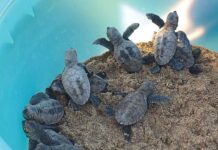By Jill Engledow | Photography by National Park Service / Ron Dahlquist
 Hike into Haleakala Crater on the Halemau‘u Trail’s rocky ledges, and you’ll pass a million delicate alpine plants, their leaves glistening in the mountain mist. Walk down Sliding Sands Trail, and you’ll see hundreds of shimmering silverswords scattered over the multicolored cinder cones that stretch across the crater’s vast floor.
Hike into Haleakala Crater on the Halemau‘u Trail’s rocky ledges, and you’ll pass a million delicate alpine plants, their leaves glistening in the mountain mist. Walk down Sliding Sands Trail, and you’ll see hundreds of shimmering silverswords scattered over the multicolored cinder cones that stretch across the crater’s vast floor.
On the thick pad of grass outside the sturdy cabin at Holua, nene (Hawaiian geese) waddle and honk, their calls echoing from the crater’s lofty cliffs. Down Kaupo Gap, a wonderland of native forest is filled with ferns, ‘ohelo bushes, and tiny red i‘iwi birds flitting through the silvery green branches of koa. Across the mountain, carefully guarded from the damaging intrusion of ravaging animals or weed-seed-carrying boots, the Kipahulu Valley nurtures an unmatched collection of native flora.
The idyllic scenery seems untouched and thriving. But not too long ago, this ancient natural beauty nearly disappeared, threatening to leave Haleakala’s eternal vista of cinder cones, clouds and sky without its unique and intricate web of living things. As it celebrates its 90th anniversary this year, Haleakala National Park can also celebrate considerable success in rescuing and caring for these treasures.
“A national park’s success depends first on having a land base, and then on building a constituency,” says Chief of Interpretation Dominic Cardea. “The two tend to feed on each other; community support is necessary to establish a land base for a national park, which then allows more people to learn about and love the park’s beauty, creating a greater constituency to protect, preserve, and restore the land. People who experience and enjoy the landscape learn to value the idea of preserving natural and cultural heritage everywhere.”
Ninety years ago, only the hardiest horseback riders enjoyed the magnificent views at Haleakala’s summit. Tourists plucked silversword plants to take home as proof that they had been up the mountain. Feral goats ravaged every sprout of green. The nene were practically extinct.
Haleakala summit was included, along with the Kilauea and Mauna Loa areas of Hawai‘i Island, when the Hawai‘i National Park was created on August 1, 1916—the same month President Woodrow Wilson signed legislation establishing the National Park Service to care for 14 parks and 21 monuments.
The Kilauea section drew most of the attention because of fascination with its active volcanoes. But on Maui, people had long appreciated the beauty of Haleakala. For the Hawaiians, Haleakala summit has always been the realm of the gods, a place where only a few ventured, on foot and at the mercy of the elements. Independent travelers throughout the 1800s braved the trip on horseback, carrying their own camping gear. Early 20th-century tourists left Wailuku for a two-hour auto drive to Olinda, followed by a guided three-and-a-half-hour, eight-mile horseback climb to spend a chilly night at the rest house at the summit.
The original rest house, a simple shelter financed in 1894 by a group of Maui citizens, was rebuilt several times over the next few decades by the Maui Chamber of Commerce. The Chamber and others in the community were all in favor of Congress’s making Haleakala’s summit a national park.
Still, even after it was officially established, the Park Service was reluctant to develop the new park while private parties still controlled the summit. One of them, Haleakala Ranch, owned most of the crater floor and used it as a shortcut across the mountain, herding grazing cattle up and down Kaupo Gap.
Only after the private owners traded their summit lands for other property did work begin on a road to the peak.
The opening of the new “Speedway to the Sun” in 1936 was dubbed “the most important event in Maui’s recent history” by The Maui News. The Territorial Senate took a holiday, Maui employers gave their workers a day off, and 320 automobiles journeyed over the new road for opening celebrations at the peak.
Inside the crater, young workers in the Depression-era Civilian Conservation Corps were busy preparing the great valley for the visitors the new road would bring. The men repaired old trails and laid out new ones, and built cabins at Holua, Kapalaoa, and Paliku, plus a ranger cabin at Paliku.
The park continued to grow, with the most important expansion being one that stretched its territory through pristine native forest to the sea. Part of the upper Kipahulu Valley was added in 1951. Then millionaire Laurance Rockefeller acquired land that included some of the famous pools of ‘Ohe‘o, but he could not give it to the park service because only “contiguous” lands may be added to national parks. So Rockefeller launched a campaign to buy the lower Kipahulu Valley, thus creating the connection that established the park’s Kipahulu section in 1969.
The Kipahulu addition, with its untouched forest full of endangered native species, is one example of how the park’s constituency has helped build the land base.
Once the land is acquired, the fight begins to save those unique features that made it worth acquiring in the first place.
In Haleakala, a primary foe has been the goat, and the winning weapon, a fence. Introduced to Hawai‘i in the early 1800s, flocks of goats soon found their way up the mountain. By the late 20th century, “We were shooting goats by the thousands,” says Ron Nagata, who worked on early Haleakala fencing efforts as a Sierra Club volunteer in 1976 and is now chief of resources management. Haleakala and Hawai‘i Volcanoes National Parks had become separate entities in 1961, but they shared the problem of feral animals destroying native vegetation. Don Reeser, Haleakala’s superintendent from 1988 to 2005, pioneered fencing on the Big Island, proving that it would work and modeling a new kind of resource management for the entire National Park Service.
On Haleakala, Nagata also experimented with various types of fencing, and came up with the idea of adding a line of barbed wire at ground level to keep pigs out. By the time Reeser was appointed superintendent at Haleakala, fencing there was well under way. By 1991, the last of some 17,000 goats had been cleared from the Park. Today more than 85 miles of fencing protect the summit and Kipahulu, and the work continues.
Maintaining the fences is a never-ending task; in addition to constant monitoring and replacement because of natural corrosion, some sections of four-foot fencing now must be replaced with six-foot fence to keep out the axis deer that are multiplying across the island.
But fencing is also an extremely rewarding task. The trail down Kaupo Gap is a spectacular example of the resurgence of native forest. “Thirty years ago, you would not see young ‘ohi‘a, koa, mamane, a‘ali‘i,” says Ted Rodrigues, who’s in charge of feral animal control at Haleakala. “What you saw was an old forest, slowly dying.” Once goats were excluded, “the seedlings would come up by the thousands in Kaupo Gap.”
While “exclosure” kept out goats and pigs, allowing plant life to revive, the nene was restored through efforts that began in 1962, when Boy Scouts carried 35 birds to Paliku in cardboard boxes tied to the boys’ backs. Extinct on Maui since the 1930s, a flock of the formerly plentiful birds had been preserved in a wildlife institution in England. Now nene are a common sight in and around the park.
One way to support the nene and other endangered species is through the Friends of Haleakala National Park, also celebrating an anniversary this year. Mary Evanson, founder and president of the organization, says the Friends’ fund-raising “Adopt a Nene” program was suggested by park Wildlife Biologist Cathleen Bailey, who attended one of the first Friends’ meetings after the group’s founding 10 years ago. Adoption donations go to the park’s endangered species program.
 The Friends also sponsor service trips to help with nene or silversword counts, or with another current park priority, the removal of alien plant species. Each December, the public is invited to participate in a tree-clearing day at Pu‘unianiau, near the park entrance. The alien pine trees there make great Christmas trees, and their removal increases the chance for native species to revive.
The Friends also sponsor service trips to help with nene or silversword counts, or with another current park priority, the removal of alien plant species. Each December, the public is invited to participate in a tree-clearing day at Pu‘unianiau, near the park entrance. The alien pine trees there make great Christmas trees, and their removal increases the chance for native species to revive.
The group also publishes a newsletter, puts on public information meetings, and speaks out on park-related issues. “Hopefully, we are a voice to be reckoned with,” Evanson says.
The Friends is an example of the constituency every park needs, says Dominic Cardea. “We couldn’t do it alone. National parks used to be thought of as ‘islands of hope,’ but now we realize we can’t isolate ourselves.”
Examples abound, from the wealthy individuals who loved Kipahulu and worked with The Nature Conservancy to establish the Kipahulu section, to the students and service groups who fix trails and pull weeds. The Kipahulu ‘Ohana works with the park to restore ancient taro patches and shares Hawaiian culture with visitors there. The Hawai‘i Natural History Association raises funds for interpretive and research projects through book sales at both the summit and the Kipahulu headquarters. Cooperative efforts with the Maui Invasive Species Committee and East Maui and Leeward Watershed Partnerships help to control invasive species like miconia, kahili ginger, and guava, and to encourage the growth of native forests.
The National Park Service is really good at building such constituencies, Cardea says. And these partners are essential in a battle whose goal is nothing less than the perpetual preservation of Haleakala National Park’s 30,183 acres of fragile splendor.




